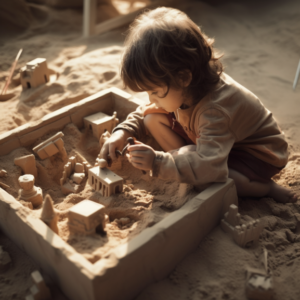Are you worried that your child is more anxious than they should be? You’re not alone, as studies show one in eight children suffer from childhood anxiety disorders. This blog post will help identify signs of excessive anxiety and provide practical strategies for managing it.
Take heart, the journey towards better mental health begins here.
Key Takeaways
- Anxiety disorders are prevalent in children and adolescents, with nearly one in three teenagers encountering an anxiety disorder.
- Common symptoms of childhood anxiety include excessive worry, restlessness, difficulty concentrating, irritability, and physical symptoms like headaches or stomachaches.
- It is important to distinguish between normal worry and excessive worry, as excessive worry may indicate the presence of an anxiety disorder that requires professional intervention.
- Tools for diagnosing childhood anxiety include clinical interviews, questionnaires and rating scales, behavioral observations, psychological tests, and collaboration with other professionals.
- Common types of anxiety disorders in children include generalized anxiety disorder (GAD), social anxiety disorder (social phobia), separation anxiety disorder, and obsessive-compulsive disorder (OCD).
- Deep breathing and muscle relaxation techniques can be effective strategies for managing childhood anxiety. Techniques such as belly breathing, progressive muscle relaxation, visualization exercises, and counting exercises can help calm a child’s mind and body.
Understanding Anxiety in Children
Anxiety in children is a common psychological condition that can significantly impact their daily lives.
Definition of anxiety
Anxiety refers to feelings of extreme worry or stress that last for a substantial period and interfere with daily activities. It’s not just about being anxious about upcoming events, like exams or presentations.
It entails persistent distress that doesn’t fade away after the worrying situation ends. An individual suffering from anxiety experiences physical symptoms such as rapid heartbeat, sweating, nervousness and may also develop unfounded fears.
Unlike everyday worries experienced by everyone now and then, these intense feelings do not easily go away and worsen over time if left untreated. Anxiety disorders are classified under mental health conditions, among which several types can affect children specifically.
Prevalence in children and adolescents
Anxiety disorders rank among the most common mental health issues affecting children and adolescents today. Studies show that nearly one in three adolescents between ages 13 and 18 will encounter an anxiety disorder, marking a significant prevalence.
This statistic increases when we consider the number of unreported cases. Childhood is often when these disorders initially appear, laying the groundwork for mental health struggles in later life.
The prevalence can be attributed to various factors such as genetic predisposition, environmental stresses, or traumatic experiences at early ages. The onset of puberty also escalates anxiety symptoms in teenagers due to hormonal changes and new social challenges faced during adolescence.
Despite their high occurrence rates, anxiety disorders are frequently overlooked or misunderstood in pediatric populations making them more difficult to address effectively.
Impact on daily life
Anxiety disorders in children can dramatically disrupt their daily life. Ordinary tasks become daunting challenges hampered by panic and fear. In many instances, the child might avoid social interactions and activities they previously enjoyed due to heightened worry or anxiety.
School performance often suffers as the pervasive sense of unease interferes with focus and concentration.
The ripple effects reach beyond their personal experiences, impacting family dynamics as well. Parents or caregivers often find themselves having to continually reassure distressed kids suffering from childhood anxiety, leading to increased stress within the household.
Likewise, siblings may feel confused by their brother’s or sister’s behaviors brought on by pediatric anxiety. Hence, managing childhood anxiety becomes crucial for both the affected child and those around them.
Identifying Anxiety in Children
To identify anxiety in children, it is important to recognize common symptoms such as excessive worry, restlessness, difficulty concentrating, irritability, and physical symptoms like headaches or stomachaches.
Symptoms to look for
Children experiencing anxiety may exhibit various signs and symptoms. It is important for parents, educators, and caregivers to be aware of these indicators in order to identify and address childhood anxiety effectively. Look out for the following symptoms:
- Excessive worrying about everyday activities or events
- Difficulty concentrating or focusing on tasks
- Physical symptoms such as headaches, stomachaches, or nausea
- Restlessness or feeling on edge
- Irritability or anger outbursts
- Sleep disturbances, including trouble falling asleep or staying asleep
- Avoidance of certain situations or places due to fear or discomfort
- Constant need for reassurance
- Overthinking and imagining worst-case scenarios
Differences between normal and excessive worry
Normal worry is a typical and common experience for children, while excessive worry may indicate the presence of an anxiety disorder. Normal worry involves concerns about everyday situations like schoolwork or making new friends.
It often comes and goes, doesn’t interfere with daily life, and can be managed with support from parents or caregivers. On the other hand, excessive worry is persistent, overwhelming, and difficult to control.
It may cause significant distress and impair a child’s functioning in various areas such as school performance or social interactions. Recognizing the differences between normal worry and excessive worry is crucial for identifying potential anxiety disorders in children and providing appropriate support.
Tools for diagnosis
Diagnosing childhood anxiety can be done using various tools. These tools allow professionals to assess and identify anxiety in children effectively. Consider the following methods for diagnosing childhood anxiety:
- Clinical interview: Mental health professionals conduct interviews with the child and their parents or caregivers to gather information about symptoms, triggers, and overall functioning.
- Questionnaires and rating scales: Standardized questionnaires, such as the Screen for Child Anxiety Related Emotional Disorders (SCARED) or the Multidimensional Anxiety Scale for Children (MASC), are used to assess the severity and specific types of anxiety symptoms.
- Behavioral observations: Professionals may observe a child’s behavior in different settings, such as home or school, to look for signs of anxiety, like avoidance or excessive worry.

- Psychological tests: Various psychological tests, such as projective tests or personality inventories, can provide additional insights into a child’s emotional well-being and help identify underlying factors contributing to anxiety.
- Collaboration with other professionals: Mental health professionals may collaborate with pediatricians, teachers, and other relevant individuals involved in the child’s life to gather comprehensive information and determine an accurate diagnosis.
Common Types of Anxiety Disorders in Children
Common types of anxiety disorders in children include generalized anxiety disorder, social anxiety disorder, separation anxiety disorder, and obsessive-compulsive disorder (OCD). Learn more about these disorders and how they can be managed.
Generalized anxiety disorder
Generalized anxiety disorder (GAD) is one of the most common anxiety disorders in children and adolescents. It is characterized by excessive worry and fear about a wide range of everyday situations or activities.
Children with GAD often have difficulty controlling their worry, which can interfere with their daily life and functioning. Symptoms of GAD may include restlessness, fatigue, irritability, muscle tension, and sleep disturbances.
Early identification and intervention are crucial to effectively manage GAD in children.
Social anxiety disorder
Social anxiety disorder, also known as social phobia, is a form of anxiety that affects children and adolescents. It is characterized by an intense fear or worry about social situations and the fear of being judged or embarrassed in front of others.
Children with social anxiety disorder may avoid social interactions, such as speaking in public or participating in group activities. They may also experience physical symptoms like sweating, trembling, or rapid heartbeat when faced with these situations.
Cognitive-behavioral therapy and medication are common treatment options for managing social anxiety disorder in children. By addressing their fears and providing support, parents and educators can help children overcome the challenges associated with this condition.
Separation anxiety disorder
Separation anxiety disorder is a common type of anxiety disorder in children. It occurs when a child experiences extreme distress and fear when separated from their primary caregiver or home environment.
Symptoms of separation anxiety disorder can include excessive worry about being separated, nightmares about separation, physical symptoms like headaches or stomachaches, and refusal to go to school or be away from their caregiver.
Treatment for separation anxiety disorder may involve cognitive-behavioral therapy, which helps the child learn coping strategies and manage their fears.
Obsessive-compulsive disorder (OCD)
Obsessive-compulsive disorder (OCD) is a type of anxiety disorder that commonly affects children and adolescents. Children with OCD experience repetitive, intrusive thoughts called obsessions, which cause them to feel anxious or distressed.
In order to alleviate this anxiety, they engage in repetitive behaviors known as compulsions. These compulsions provide temporary relief from the obsessive thoughts but can significantly impair their daily functioning.
Common obsessions in children with OCD include worries about germs or contamination, fear of harm coming to themselves or others, perfectionism, and unwanted aggressive thoughts. Compulsions may involve excessive handwashing, checking behaviors (such as repeatedly making sure doors are locked), counting rituals, or arranging items in a specific order.
Managing Anxiety in Children
To manage anxiety in children, it is important to teach them deep breathing and muscle relaxation techniques.
Deep breathing and muscle relaxation techniques
Deep breathing and muscle relaxation techniques can be effective strategies for managing anxiety in children. These techniques help children calm their minds and bodies, reducing feelings of stress and tension. They can also be used as tools to prevent anxiety from escalating into a full-blown panic attack. Here are some techniques that can be helpful:
- Belly breathing: Teach your child to take slow breaths, filling their belly with air as they inhale, and then exhaling slowly.
- Progressive muscle relaxation: Guide your child through tensing and relaxing each muscle group in their body, starting from their toes and moving all the way up to their head.
- Visualization: Encourage your child to imagine a peaceful place or scenario, guiding them to visualize the details using all of their senses.
- Counting exercises: Have your child count slowly from one to ten or count backwards from ten to one, focusing on the numbers and nothing else.
- Guided imagery: Use recordings or apps that provide guided relaxation exercises for children to follow along with.
Positive self-talk
Positive self-talk is an effective strategy for managing childhood anxiety. By using encouraging and uplifting words, children can shift their mindset and reduce anxious thoughts. Teaching kids to replace negative self-talk with positive affirmations can help build confidence and resilience.
For example, instead of saying “I can’t do it,” they can say “I’ll try my best.” This simple change in language can empower children to face their fears and challenges with a more positive outlook.
Encouraging positive self-talk is a valuable tool in helping children manage their anxiety and develop a strong sense of self-esteem.
Cognitive-behavioral therapy
Cognitive-behavioral therapy (CBT) is an effective approach for managing childhood anxiety. This therapeutic technique focuses on helping children identify their negative thought patterns and replacing them with more positive and realistic ones.
Through CBT, children learn to recognize the connection between their thoughts, feelings, and behaviors, enabling them to develop healthier coping mechanisms. By working with a trained therapist, children can gain valuable skills and strategies to manage their anxiety in various situations.
CBT empowers children by teaching them practical techniques such as relaxation exercises, challenging irrational beliefs, and gradually facing feared situations. With consistent practice and guidance from mental health professionals, cognitive-behavioral therapy can significantly improve anxiety symptoms in children while promoting long-term resilience.
Medications
Medications can be a helpful tool in managing childhood anxiety. Certain medications, such as selective serotonin reuptake inhibitors (SSRIs), can help to reduce anxiety symptoms in children and adolescents.
These medications work by increasing the levels of serotonin in the brain, which is a neurotransmitter that helps regulate mood and emotions. SSRIs are typically used for treating generalized anxiety disorder, social anxiety disorder, and obsessive-compulsive disorder.
It’s important to note that medication should always be prescribed and monitored by a qualified healthcare professional who specializes in pediatric mental health. They will assess the child’s individual needs and determine if medication is necessary as part of their comprehensive treatment plan for managing childhood anxiety.
Tips for Parents and Educators
Encourage open communication, provide a supportive and understanding environment, and collaborate with mental health professionals for effective management of childhood anxiety.
Encouraging open communication
Parents and educators play a crucial role in helping children manage their anxiety by encouraging open communication. Creating a safe and supportive environment where children feel comfortable expressing their fears, concerns, and worries can make a significant difference in their ability to cope with anxiety.
By actively listening to children without judgment or interruption, adults can gain a deeper understanding of what triggers their anxiety and provide appropriate support. Encouraging open communication also allows for the opportunity to teach effective coping strategies, validate their feelings, and help them develop resilience in managing their anxiety.
Providing a supportive and understanding environment
Creating a supportive and understanding environment is crucial when it comes to managing childhood anxiety. Children with anxiety need to feel safe, heard, and understood in order to effectively cope with their worries.
This can be achieved by offering reassurance, actively listening without judgment, and validating their feelings. Additionally, parents and educators should strive to maintain consistent routines and clear expectations, as structure can help alleviate anxiety symptoms.
By providing an atmosphere that promotes open communication and empathy, children experiencing anxiety will feel supported in their journey towards better mental health.
Collaborating with mental health professionals
Collaborating with mental health professionals is crucial in effectively managing childhood anxiety. These professionals, such as therapists and counselors, have specialized training and expertise in understanding and treating anxiety disorders in children.
By working together with them, parents and educators can gain valuable insights into the child’s anxiety symptoms, triggers, and strategies for coping. Mental health professionals can provide guidance on evidence-based treatments like cognitive-behavioral therapy (CBT) or recommend appropriate medications if necessary.
They also play a vital role in supporting parents and educators by offering advice on creating a supportive environment at home and school. Collaborating with mental health professionals ensures that children receive comprehensive care tailored to their specific needs.
Conclusion
In conclusion, it is crucial for parents and educators to recognize the signs of anxiety in children and adolescents. By implementing effective strategies such as deep breathing exercises, positive self-talk, cognitive-behavioral therapy, and medication when necessary, we can support children in managing their anxiety.
Creating a supportive environment that encourages open communication and collaboration with mental health professionals will also be beneficial in helping children cope with their anxiety.
